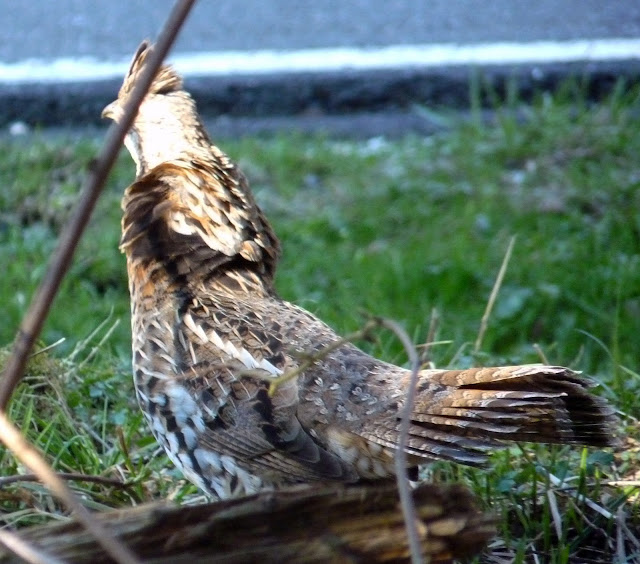Somehow I ended up birding the NC mountains last weekend.
Why?
I blame Mark K. I had resigned myself to never see an Evening Grosbeak, but when he offered to do the driving and had a free place to stay, how could I say 'no?'
What an awesome bird!
This was supposedly an irruption year for Evening Grosbeaks in North Carolina, the first since about 1996. But other than a few flyovers and fleeting glimpses by feeder-watchers, the species all but eluded triangle birders. Whether their scarcity was because the invasion was overblown or because of the species' troubling decline in recent decades, I can't say.
All I know is that four pairs (at least) showed up in Bryson City, NC this April and have been essentially the only ones to stay in place long enough for NC birders to see in the past decade or so.
A big thanks to Andy Zivinsky of Bryson City Bicycles for being so generous with his time and yard!
~~~
Some notes for listing nerds:
This was North Carolina bird #340 for me. I've still got a dozen or so reasonably target-able birds to find in NC, but after 350, the diminishing returns really kick in and it'll be mostly about having luck on Christmas Bird Counts and chasing down rarities to add state ticks.
Here's my prediction for the next 10 NC species that would take me to #350:
Willow Flycatcher - I'm pretty sure I've already seen one at Mason Farm, but it didn't call and so went down as Empidonax sp.
Golden-winged Warbler - I should get this (and above) in a few weeks if I go up to the New River near Boone
Northern Saw-whet Owl - the last NC breeder I need as a lifer. I tried for and missed it on this Grosbeak trip
Swallow-tailed Kite - I have a chance to find one with Ed Corey at the Cape Fear during Wild-a-Thon
Leach's Storm-Petrel - I've got plans to spot on some pelagics this summers, so I might get one or two of the four pelagic species listed here
Sooty Shearwater
White-tailed Tropicbird
South Polar Skua
Hudsonian Godwit - Mattamuskeet is supposed to be a good place to see them and fall and I'll be out that way doing field work
Yellow-bellied Flycatcher - A rare fall migrant I hope to stumble upon
With some luck, I'll get to 350 before next winter one way or another...probably with four of five from the list above. Winter birds I need, like Western Kingbird, Glaucous Gull and Cave Swallow, should come in the next batch.
Why?
 |
| Evening Grosbeaks |
 |
| Evening Grosbeaks |
This was supposedly an irruption year for Evening Grosbeaks in North Carolina, the first since about 1996. But other than a few flyovers and fleeting glimpses by feeder-watchers, the species all but eluded triangle birders. Whether their scarcity was because the invasion was overblown or because of the species' troubling decline in recent decades, I can't say.
 |
| Evening Grosbeaks |
| Mark and I with Andy Zivinsky, the Evening Grosbeak host and owner of Bryson City Bicycles |
A big thanks to Andy Zivinsky of Bryson City Bicycles for being so generous with his time and yard!
~~~
Some notes for listing nerds:
This was North Carolina bird #340 for me. I've still got a dozen or so reasonably target-able birds to find in NC, but after 350, the diminishing returns really kick in and it'll be mostly about having luck on Christmas Bird Counts and chasing down rarities to add state ticks.
Here's my prediction for the next 10 NC species that would take me to #350:
Willow Flycatcher - I'm pretty sure I've already seen one at Mason Farm, but it didn't call and so went down as Empidonax sp.
Golden-winged Warbler - I should get this (and above) in a few weeks if I go up to the New River near Boone
Northern Saw-whet Owl - the last NC breeder I need as a lifer. I tried for and missed it on this Grosbeak trip
Swallow-tailed Kite - I have a chance to find one with Ed Corey at the Cape Fear during Wild-a-Thon
Leach's Storm-Petrel - I've got plans to spot on some pelagics this summers, so I might get one or two of the four pelagic species listed here
Sooty Shearwater
White-tailed Tropicbird
South Polar Skua
Hudsonian Godwit - Mattamuskeet is supposed to be a good place to see them and fall and I'll be out that way doing field work
Yellow-bellied Flycatcher - A rare fall migrant I hope to stumble upon
With some luck, I'll get to 350 before next winter one way or another...probably with four of five from the list above. Winter birds I need, like Western Kingbird, Glaucous Gull and Cave Swallow, should come in the next batch.





